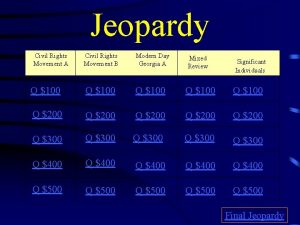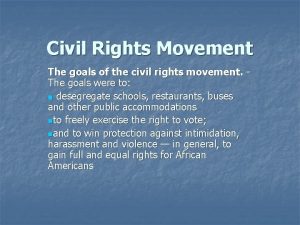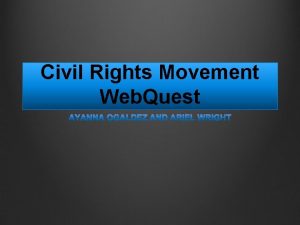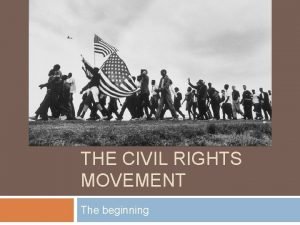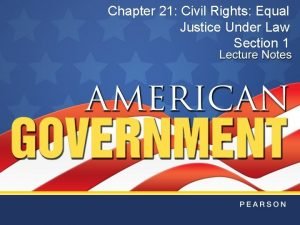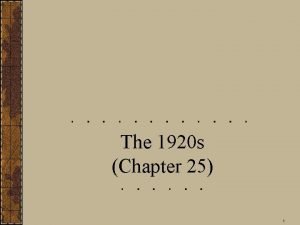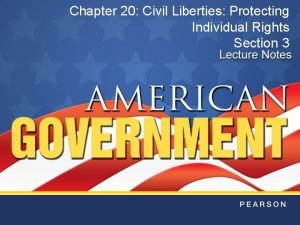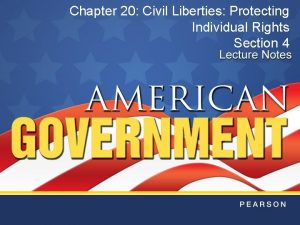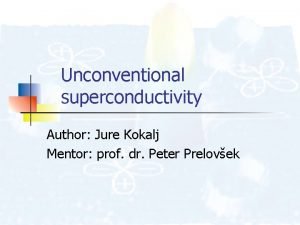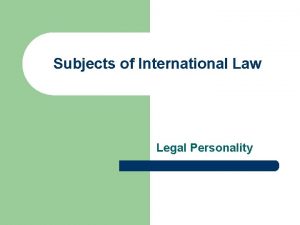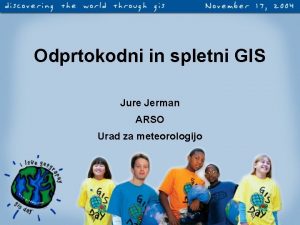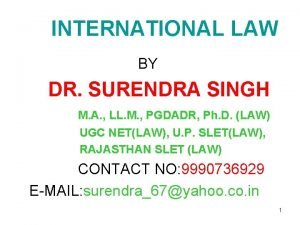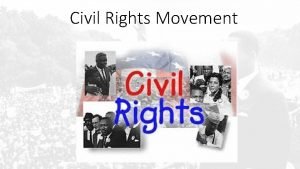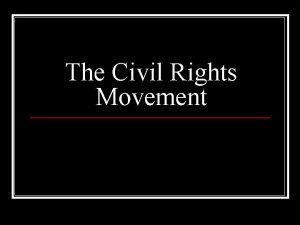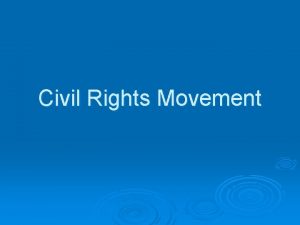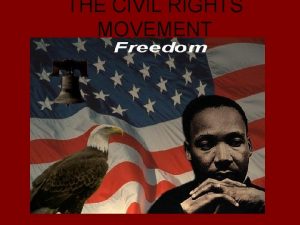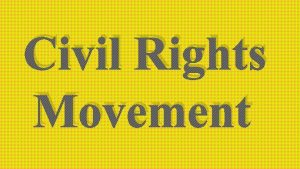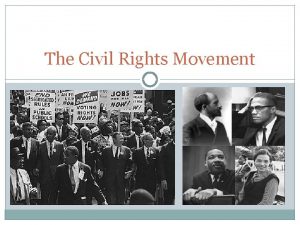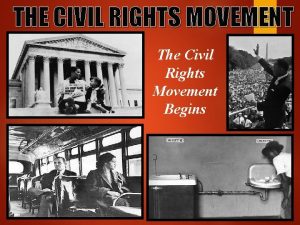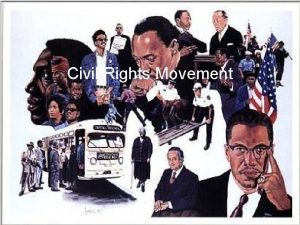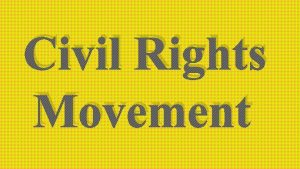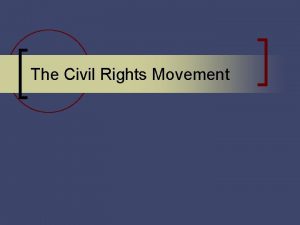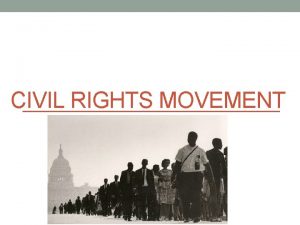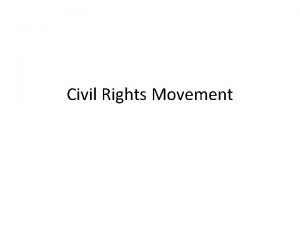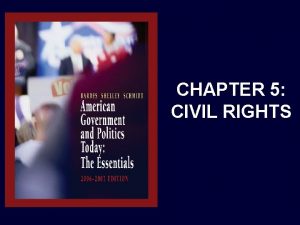The Civil Rights Movement Chapter 27 De Jure


















- Slides: 18

The Civil Rights Movement Chapter 27

De Jure Segregation / De Facto Segregation ¡ De Jure Segregation – Segregation by law; Southern states had enacted Jim Crow laws following the Civil War, supported by the Supreme Courts ruling in Plessy v. Ferguson (1896) that such laws were constitutional as long as facilities were “separate but equal. ” ¡ De Facto Segregation – Segregation by custom or tradition; Nationwide African-Americans were forced to follow “unwritten rules”, being denied housing, employment, and service in private businesses due to their race.

Jackie Robinson ¡ The first African American to play major league baseball; In 1947 Robinson joined the Brooklyn Dodgers, swearing to the team owner that for 2 years he would not respond publicly to racist attacks. Robinson braved death threats and physical & verbal abuse, but won the hearts of millions through his play on the field, opening the way for integration of all professional sports.

Brown v. Board of Education / Earl Warren ¡ Brown v. Board of Education (1954) – In a case argued by Thurgood Marshall of the NAACP, the Supreme court ruled that the concept of “separate but equal” was unconstitutional, leading to eventual integration. ¡ Earl Warren – Supreme Court Chief Justice during the Brown case, Warren wrote the court’s decision, stating “segregation of children by race… deprives children of the minority group of an equal education. ”

Civil Rights Act of 1957 ¡ Law establishing the United States Civil Rights Commission, which had the power to investigate violations of civil rights. Though in its early years the Commission did little to investigate and end discriminatory practices, the law is significant as the first Civil Rights bill passed by Congress since Reconstruction.

Closure Question #3: Why is the Montgomery bus boycott considered a turning point in the civil rights movement? (At least 1 sentence) Rosa Parks / Montgomery Bus Boycott ¡ Rosa Parks – An African American seamstress who, on December 1, 1955, refused to comply with a Montgomery, Alabama law requiring her to give up her seat on a city bus to a white passenger. Parks was arrested, sparking a chain of events leading to the Montgomery Bus Boycott. ¡ Montgomery Bus Boycott (1955 -1956) – Organized by civil rights leaders in Montgomery, including Martin Luther King Jr. , African Americans refused to ride the city buses in protest of city law. The loss of money by the city bus company combined with a ruling by the Supreme Court led the law to be overturned in late 1956.

Dr. Martin Luther King Jr. (1929 -1968) ¡ Southern Baptist minister who became the voice of the Civil Rights Movement in the late 1950 s and 1960 s; Inspired by Mohandas Gandhi, King led non-violent protests against segregation in the south and inspired Americans, both white and black, with his public speeches. King was assassinated in Memphis, Tennessee on April 4 th, 1968.

Closure Question #1: Why were sit-ins often a successful tactic? (At least 1 sentence) Sit-In / Student Nonviolent Coordinating Committee ¡ Sit-In - Peaceful protest in which African Americans sat in white-only restaurants waiting to be served; On February 1, 1960 four African American students sat at a lunch counter in Greensboro, North Carolina, sparking a wave of similar protests across the southern United States. ¡ SNCC – Grass-roots student-organized civil rights group which organized peaceful protests during the 1960 s.

Closure Question #2: Why did the freedom rides lead to violence? (At least 1 sentence) “Freedom Ride” ¡ (Spring 1961) Two buses filled with African American protesters departed Washington D. C. to travel through the South to New Orleans. Along the way they challenged segregation laws, using whites only restrooms. In Alabama one of the busses was firebombed and a white mob attacked the riders, leading President Kennedy to take steps to protect the riders, officially desegregating interstate transportation.

James Meredith / Medgar Evers ¡ James Meredith – Air Force veteran who, in 1962, became the first African American to attend University of Mississippi. Though he had to be guarded from anti-integrationist southerners throughout his time at Ole Miss, Meredith finished his studies there, graduating in 1963. ¡ Medgar Evers – Civil rights activist and leader of the NAACP in Mississippi; Evers played a key role in helping Meredith attend Ole Miss, but tragically was assassinated on his front doorstep in June 1963.

March on Washington ¡ August 28, 1963 – More than 200, 000 civil rights protesters converged on the Lincoln Memorial in Washington D. C. The highlight of the protest was Martin Luther King Junior’s “I Have a Dream” speech, which was watched by millions of Americans nationwide on TV. The event is viewed as a major turning point in American public opinion regarding civil rights.

Filibuster / Civil Rights Act of 1964 ¡ Filibuster – Tactic by which senators give long speeches to hold up legislative business; In 1964 a group of Southern senators held up passage of the Civil Rights Act of 1964 for 80 days until supporters finally put together enough votes to overcome it. ¡ Civil Rights Act of 1964 – Banned segregation in public accommodations and gave the federal government the ability to compel schools to desegregate and prosecute individuals who violate people’s civil rights.

Freedom Summer / Fannie Lou Hamer ¡ Freedom Summer (1964) – Planned by the SNCC, about 1, 000 volunteers, mostly black and white students, went to Mississippi to help register African Americans to vote and form the Mississippi Freedom Democratic Party, an alternative to the state’s all-white regular Democratic Party. ¡ Fannie Lou Hamer – Leader of the MFDP who attended the Democratic Party convention in New Jersey in August 1964; Hamer & other MFDP representatives sought recognition as Mississippi’s only Democratic Party, giving testimony of the brutal treatment of African Americans by white democrats. However, the MFDP was not seated at the convention.

Closure Question #1: How did the Selma march help lead to the passage of civil rights legislation? (At least 1 sentence) Voting Rights Act / 24 th Amendment ¡ Voting Rights Act (1965) – Influenced by violence against protesters marching for voting rights in Selma, Alabama, Congress banned literacy tests and empowered the federal government to oversee voting registration and elections. ¡ 24 th Amendment (1964) – Banned Poll Taxes, which had been used to keep the poor and minorities from voting in many states.

Kerner Commission ¡ Established by President Johnson to investigate the causes of violence in the United States; The Commission concluded that racial discrimination was the single most important cause of violence and recommended establishing and expanding federal programs to overcome the problems of America’s ghettos.

Closure Question #2: How did Malcolm X’s views differ from Martin Luther King Jr. ’s views? (At least 2 sentences) Malcolm X (1925 -1965) / Nation of Islam ¡ Malcolm X (a. k. a. Malcolm Little) – The most well-known African American radical during the 1960 s; Following a troubled youth, Malcolm was arrested for burglary at age 21. While in prison he converted to the Nation of Islam, a religious sect headed by Elijah Muhammad. After his release from prison, Malcolm X became the most prominent minister of the Nation of Islam, demanding a strict separation of the races and advocating the use of violence by African Americans to gain their rights.

Black Power / Black Panthers ¡ Black Power – Movement begun by SNCC leader Stokely Carmichael in 1966 which called for African Americans to collectively use their economic and political muscle to gain equality, not simply peaceful protest. ¡ Black Panthers – Begun in Oakland, California in 1966, members of this militant African American group organized armed patrols of urban neighborhoods to protect people from police brutality. The Panther’s style appealed to many young African Americans during the 60 s and 70 s but led to violent confrontations with police.

Assassination of Dr. King ¡ (April 4, 1968) While staying in Memphis, Tennessee in support of a sanitation workers strike, Martin Luther King Jr. was shot on the balcony of his motel room. James Earl Ray, a white ex-convict, was charged and convicted for the murder. Hundreds or race riots broke out nationwide following news of King’s death.
 Civil rights webquest
Civil rights webquest Rosa parks mother
Rosa parks mother Civil rights movement jeopardy
Civil rights movement jeopardy Civil rights movement goal
Civil rights movement goal Civil rights movement vocabulary
Civil rights movement vocabulary Civil rights movement webquest
Civil rights movement webquest The civil rights movement
The civil rights movement Civil rights movement essential questions
Civil rights movement essential questions Chapter 21 civil rights equal justice under law
Chapter 21 civil rights equal justice under law Chapter 20 civil liberties protecting individual rights
Chapter 20 civil liberties protecting individual rights Chapter 14 postwar prosperity and civil rights
Chapter 14 postwar prosperity and civil rights Chapter 14 postwar prosperity and civil rights
Chapter 14 postwar prosperity and civil rights Chapter 20 civil liberties protecting individual rights
Chapter 20 civil liberties protecting individual rights Chapter 20 civil liberties protecting individual rights
Chapter 20 civil liberties protecting individual rights Jure kokalj
Jure kokalj Jure petric
Jure petric Example of provision in law
Example of provision in law Jure jerman
Jure jerman De jure and de facto sovereignty
De jure and de facto sovereignty


